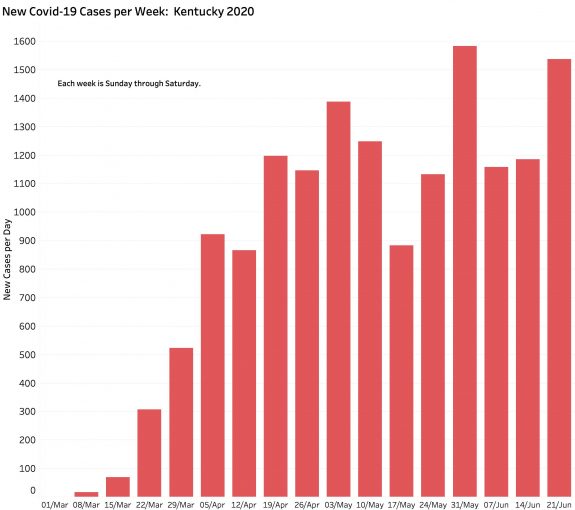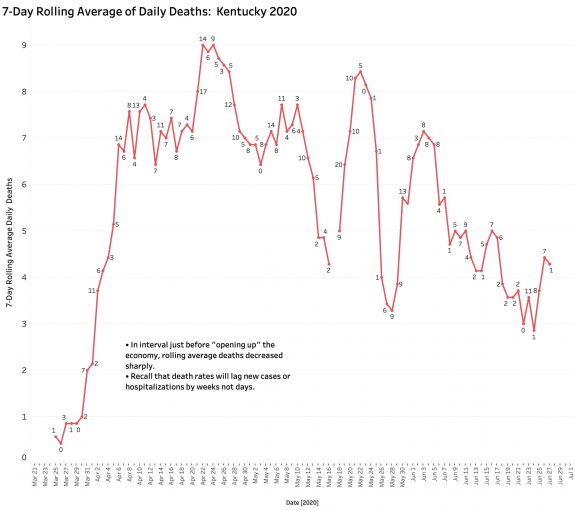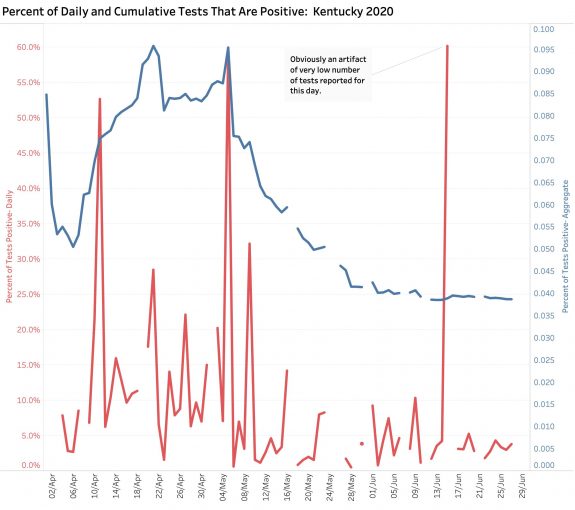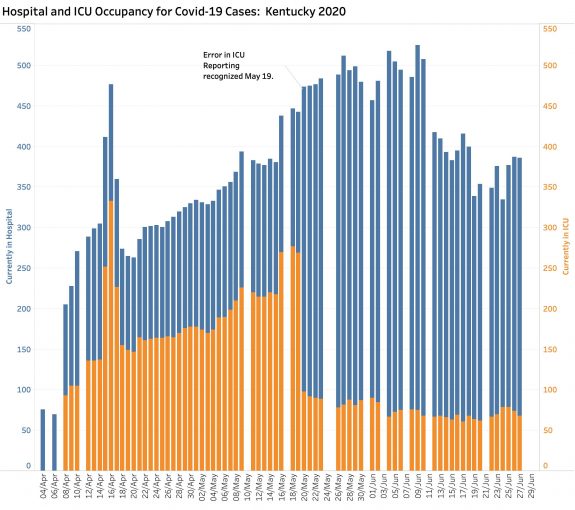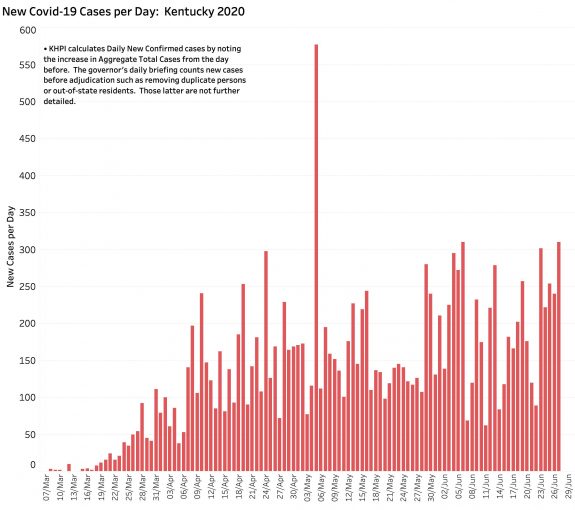What happens in Myrtle Beach does not stay in Myrtle Beach!
When I last wrote in these pages on June 8, Memorial Day was two weeks behind us, and retail stores and other public venues in Kentucky had recently taken an intermediate step opening up to the general public. Parking lots, roads, and sidewalks were noticeably more populated. Masks appeared to be optional. Perhaps and probably not coincidently, by June 6 both new daily-reported cases (310) and 7-Day rolling average of new cases (226) hit all-time highs for Kentucky’s part of the epidemic! This change was large enough that the New York Times included Kentucky in its daily tally of states in which the numbers of new cases were increasing fastest. Over the next 2 weeks or so, our state was regrouped by the Times with states whose numbers were decreasing, and then back into the group with “mostly the same” number of new cases. Yesterday we were back in the “increasing” cohort along with 31 other states. In only 6 states or territories were cases decreasing. This considerable volatility in case reports does not inspire confidence that our system of timely epidemiological monitoring or control is adequate. New cases are exploding across the nation. Current Kentucky numbers are rising as well. The following graphic tracks the 7-Day rolling average of new cases in Kentucky and an estimate of the Basic Reproductive Rate as of June 27, 2020. An assortment of other visualizations are presented at the end of this article. Interactive online versions of the complete portfolio of visualizations are available at the KHPI Public Tableau website.
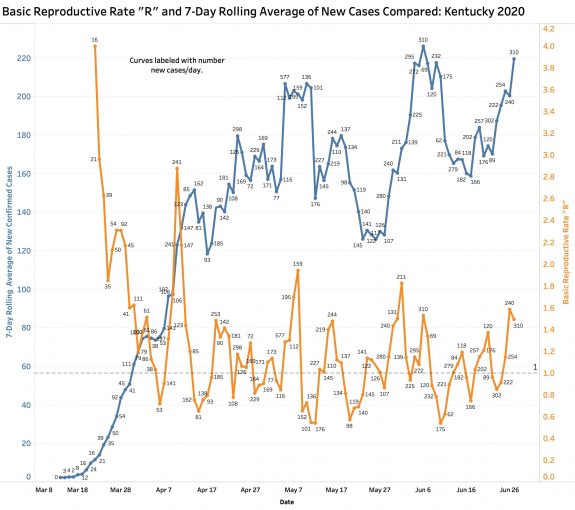
Where do we go from here?
Today, Kentucky bars are being allowed to serve liquor for the first time since the big shutdown. In at least some other states where Covid-19 is back on the rise bars are being closed again. It is impossible not to assume that alcohol-fueled spread of Covid-19 has and will play at least some role the trajectory of local epidemics. Social turmoil and outright refusal by some individuals and institutions to follow even basic public health measures will also push us in the wrong direction. An important question that I cannot answer is whether we have the infrastructure in place to pinpoint where new cases are coming from in sufficient detail, or in a timely-enough manner to do something about it without having to revert back the painful steps we have taken together.
I have spent much time in these pages refreshing my knowledge of epidemiology; and learning new ways of analyzing, visualizing, and mapping numerical data to follow the progress of epidemics. I experimented with different ways to determine the trajectory of our Covid-19 epidemic to answer the question of how can one tell if we are we are winning or losing– both when and where? One of my major disappointments is that I can find no federal or state government source of case-related data that includes the entire span of the 6-month pandemic in the USA– not even the previously reliable Centers for Disease Control! There are a number of reasons contributing to the highly variable and even chaotic variation in numbers of tests, cases, and deaths nationally and in Kentucky. These include that our national and local Healthcare Departments are largely fragmented, that not all units are using the same definitions of even basic terms like cases or deaths or tests, that reporting pathways are error-prone, and that they have built in delays that limit their timeliness. There has been astonishingly poor national leadership –even abandonment– in dealing with this contemporary plague.
In Kentucky, we have been successful so far in avoiding the run-away spread of disease or deaths that are reemerging in states like Texas, Florida, California or Arizona. Our hospitals have not been overwhelmed. Of the 31 hospitals mentioned above where new cases are currently increasing, Kentucky ranked 20th in the number of cases per capita. Our rate of new deaths has been going down . We can be proud.
Why do case numbers jump up and down so much?
The fact that Kentucky is working with relatively low case numbers amplifies the impact of additional cases because mathematically, even a modest number of new cases will drive averages disproportionally. When looked at in aggregate, our curves are hardly changing at all! As happens nationally, the workflow of the business of the collection and reporting of data varies by the day of the week. A low case count on a Sunday or Monday does not mean that the disease is going away, and a big jump on a Wednesday or Saturday does not necessarily mean the sky is falling. Decisions on what cases, deaths, or tests should be included in official reports tests has changed as we learn more about the clinical aspects of the illness. That is not inappropriate. Errors in the reporting chains have necessitated major corrections in counts of tests or ICU utilization. This latter will always be a challenge to avoid.
Under what cup is the data being hidden?
No “official” historical database of the when, and critically, the where of Kentucky’s cases have occurred is available– at least to me. Disappointingly, I am also unaware of a publicly available comprehensive, and downloadable national listing with details at the county level or more local geographic specificity. We need to be able to see what is happening in other states to protect Kentuckians and vice versa. The lists provided daily from Frankfort sum up cases by county, but do not allow one to effectively detect new hotspots without tedious daily manual transcription. We can see where we have been, but not where we are going. If I am asked to honestly say that I think we are where we need to be in being able to detect an early outbreak– I cannot.
Will Kentuckians be willing to stand together as our motto declares? It is obvious is that a large proportion of citizens here and in other states are unable or unwilling to adopt even such simple and fundamental measures such as wearing masks or keeping crowds small. What happens outside Kentucky will not stay outside Kentucky! No, I do not think we are ready.
Where can one find timely and reliable numbers?
I am planning to deemphasize KHPI’s updating of daily reports. For one thing, I do not have access to the necessary numbers. My several requests for advice and data from the state have not been replied to. Other national aggregating organizations have been doing a better job than I can. I can recommend the print or on-line tracking versions from the New York Times, The Covid-19 Tracking Project of The Atlantic, or the Johns Hopkins tracking project. Today, the Courier-Journal announced its launch of a Coronavirus-monitoring project for Kentucky. All of these can do a better job and have a larger audience than I!
Glass half full, or otherwise?
We should all be concerned about the back-to-the future approach taken by some in-denial states like Florida or Texas, or leaders that ignore the most trustworthy recommendations of public health scientists and officials. We cannot remain in universal lockdown forever. That is a given. However, we must be able to be more surgically efective in our interventions to protect the body public. As a lifelong clinical scientist and practitioner, I am profoundly disappointed by the dismissal of hard-earned scientific understanding of the world around us– including in biology and medicine. It is not a good sign for us as a society, or even as a species, that so many of us are willing to reject the very foundation of knowledge that has allowed the lifespan and standard of living that many (but not all of us) have enjoyed. Surely we can do better. We have to!
An interactive data visualization of these graphs and others are updated and available on KHPI’s Tableau Public Website.
Peter Hasselbacher, MD
President, KHPI
Emeritus Professor of Medicine, UofL
June 29, 2020
Additional graphics below as of June 27, 2020.
New cases of Covid 19 in Kentucky by week of epidemic.
